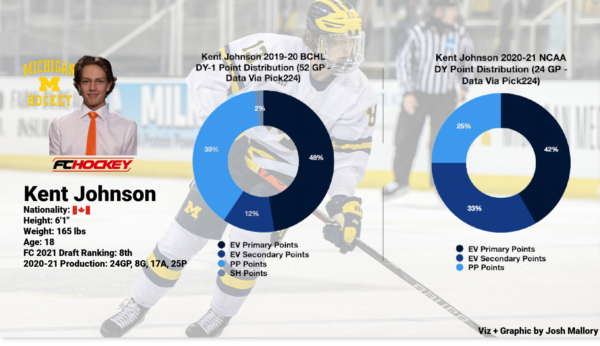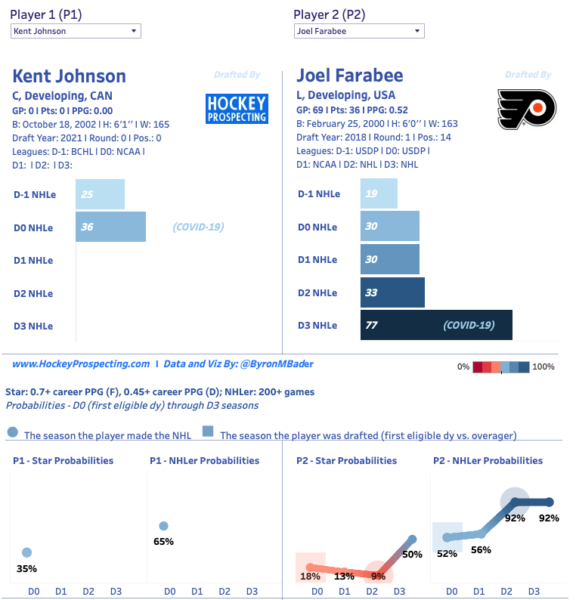PROSPECT PLAYBOOK: Breaking down Johnson’s game
Welcome to my second deep dive for FCHockey! If you haven’t already, be sure to check out my inaugural piece, where I dissect the game of FC’s No. 17-ranked Corson Ceulemans.
Overview
Today, I’m going to be taking a detailed look at FCHockey’s No. 8-ranked prospect, Kent Johnson.
After demolishing the BCHL with the Trail Smoke Eaters in 2019-20, the North Vancouver native made the leap to play for a premier NCAA program with Michigan. So far, he’s more than lived up to expectations – especially as a freshman – having posted 25 points (8G, 17A) through 24 games played thus far.
RELATED: BENIERS, JOHNSON, POWER HONOURED IN B1G AWARDS
First and foremost, Johnson is an elite planner. Seldom does he make blind or random plays on the ice; everything he does is with a purpose and has been calculated at lightning speeds prior thanks to incessant shoulder checks and pre-scans. He’s able to combine his high-end processing speed with sublime edgework and puck handling to make himself a constantly elusive and dangerous player on the ice. Johnson is always play-ready; he’s always presenting his stick as a passing target, and he holds an athletic, play-ready stance no matter where he is on the ice. He’s always seeking open space and quiet pockets on the ice in support of teammates.
Johnson possesses elite skill blending and can make complex plays inside of movement with ease; he’s routinely able to disguise his true intentions with the puck entirely until it’s too late for opposing defenders to make the right read. His command of the puck in the offensive zone is also among the best in the 2021 class. And finally, likely my favourite part of Johnson’s game, is his ability to play the game at any speed. Where some players want to constantly play at 100mph or slow the game down for themselves, Johnson frequently implements weight shifts and changes of speed to manipulate his circumstances in order to manufacture opportunities where others can’t.
The Numbers
Johnson’s numbers overall are sparkling – and a direct reflection of his quality as a hockey player. According to InStat, through his most recent 10 games, Johnson has fared very well in the shot-share department, having posted a 63 CF% at even-strength. He’s also a fantastic passer, which is supported by his 85% pass completion rate this season at evens. His box score stats have also been impressive, especially for a freshman at the NCAA level (24GP, 8G, 17A, 25P at the time of writing this).
Johnson has produced wherever he’s played, so I dug a little deeper into his DY-1 and DY point distributions to see where he most contributes offensively. Both years provided interesting insight that can in all likelihood be boiled down to his difference in roles, level of reliance from his team and quality of teammates.
ALSO READ: ANALYTICS APPROACH: KENT JOHNSON
In his DY-1 in the BCHL, Johnson was THE guy. The Smoke Eaters used Johnson in any and all offensive situations and relied on him to carry most of the load on the offensive side of the puck. He did just that. Johnson produced an absurd 101 points (41G, 60A) in 52 games in the 2019-20 season for Trail. He produced 60% of his points at even strength, which shows his ability to produce at evens at an elite level. What’s more impressive though, is that nearly half of his points were primary even-strength points. Johnson stirred the drink in Trail and drank it. Per pick224.com, he averaged a comical .92 even-strength primary points per game, by far and away the best rate among DY-1 players in the BCHL (second place was occupied by Chilliwack’s Peter Reynolds with a rate of .43 EVP1/GP).

His point distribution has changed quite dramatically with Michigan, but the year-to-year changes are very likely explained by a few factors. Johnson’s EVP1 rate has remained mostly the same, though it has dropped from 48% of his production to 42%. Where he’s seen a massive spike is in even-strength secondary points. Only 12% of Johnson’s points came as EVP2s in 2019-20; that number has jumped to 33% this year with Michigan. The very likely explanation? Quality of teammates. In Trail, Johnson was the go-to-guy on offence. With Michigan, he gets to play with the likes of Owen Power, Matty Beniers, Johnny Beecher, Brendan Brisson, Cam York, Nick Blankenburg and Thomas Bordeleau, to name just a few. He’s playing with an elite supporting cast in Michigan, which means naturally, the offence is going to be more spread out than if Johnson were relied upon to be the primary producer.
If nothing else, it’s encouraging that his EVP1 rate has remained wholly the same from last year to this; it means that he’s still an offensive driver at evens regardless of who he plays with, which is an incredibly encouraging sign for a prospect rated as high as Johnson is. The dip in percentage of production from the power play can also likely be chalked up to the loaded unit Johnson plays on that typically features Power, Beniers, Lambert and Blankenburg. Lots of threats there, meaning Johnson won’t be a direct factor on as many goals with the man advantage.
Measure Twice, Cut Once
Johnson would make a great contractor because he’s a phenomenal planner and problem solver. When he’s on the ice, he seldom makes a play without having mentally planned it (at lightning speed I might add) beforehand. His ability to be an elite ‘doer’ on the ice comes first from his ability as an elite thinker. Without the puck offensively, Johnson is constantly scanning the ice to find space and identify where teammates are so that when he gets the puck, he’s able to make the right play, or the better play, nearly every time.
MORE: JOHNSON, POWER EARN HOBEY BAKER NOMINATIONS
Here, for instance, is a great example of Johnson’s constant use of pre-scanning to build the blueprints for his next play. He finds space, presents his stick and is play ready before the play has even developed to him; thanks to his three shoulder checks prior to puck reception, he’s able to subsequently make two forecheckers look silly once he receives the pass from his teammate:
In the offensive zone, Johnson is playing chess while everyone else is playing checkers. Here, he shows off his ability to create something out of nothing along the wall. Instead of simply driving the puck deep or stopping up and going low -to-high to a D, he:
- Stops up, scans and cocks puck into hip pocket
- Fakes a spin move and stops up again
- Scans again
- Drops to an open teammate low
All of this without a single tell about what his intentions were with the puck:
Johnson is also an incredibly conscious player around the net in the OZ. In a similar manner to Patrick Kane or Mitch Marner, he’s always looking to make sneaky slip passes or reverses to the front of the net to throw goalies and D-men off and create grade-A looks for teammates. He shows this off twice in one clip here:
Off the rush, Johnson is very adept at passing early, playing between checks and fading off into open space. Here, he gives the puck up early in order to get it back shortly thereafter and put it home:
Power Play
Thanks to his ability to process the game, Johnson represents a fantastic option to initiate power play breakouts like Michigan allows him to do here. Here, he uses his shifty puck handling and edgework to deceive and successfully implement the drop pass Michigan is looking for, though the initial drop probably could have come after his second pivot:
In-zone, Johnson is as deceptive as they come. In the first instance in this clip, he jukes out the opposing penalty killer while under pressure with an open fake to get the puck back to Blankenburg. Not too long after that, he makes something out of nothing, finding Beniers off his backhand through layers of bodies for a near-chance.
And finally, Johnson has the skill-blending and footwork to routinely pull off Auston Matthews-lite catch and step shooting off his strong side halfwall:
Skill Blending + Playing Inside of Movement
Another standout component of Johnson’s game is his ability to blend skill to a very high degree of effectiveness. Here, for example, though it doesn’t result in a goal, Johnson is able to create a grade-A look from the slot thanks to a series of weight shifts and deceptive puck handling sequences to mask his intentions:
Johnson is routinely able to make and receive plays inside of movement, something that many touted prospects can struggle with at times. Catching passes behind himself without breaking stride then subsequently turning it into a controlled entry is a common occurrence. To boot, he follows up the zone entry with a beautiful backhand pass out of pressure for yet another near-chance for a teammate:
In the offensive zone, Johnson is incredibly deceptive. This clip is everything that’s great about his ability to blend shifty edgework, puck handling and constant scanning all wrapped into one sequence. I think I’ve watched the backhand to skate self-pass to escape pressure about 30 times now:
Skating
Johnson’s edgework, as well as his transitional and small space skating, are very strong. He’s also adept at changing the pace of play and playing at various speeds.
Like in this scenario, where he enters the zone with speed but pulls up to give himself time and space while finding a teammate who’s folding under to create a near-chance:
Johnson often employs linear crossovers through the neutral zone to great effect. It allows him to add considerable deception to his game and keep defenders on their heels. This goal, which went viral a few months ago, is almost Kane-esque, especially with the backhand finish in tight:
Areas to Improve
There are a few areas where Johnson can improve. First, due to his spider-heavy game, he can, at times, be reliant on teammates to get the puck back. Many players make a living off this style of play at the NHL level, but with his elite stick abilities and offensive instincts, you’d like to see him try to add a bit more bull to his game.
Second, he’s not an overly physical player, so he can tend to struggle along the boards when breaking out of his zone at times if he’s imposed upon physically. This is a common issue with young prospects and not one that worries me in the slightest. Johnson’s edgework, hands and brain constantly work in concert to allow him to solve complex problems on the ice, and for every play he doesn’t make, he’ll make three plays later that period that other players can’t. Once he packs on his pro weight and acclimates to each subsequent level he plays at, he’ll be just fine in this area.
And finally, his first-step explosiveness and his top-end speed aren’t necessarily the strongest parts of his game. Don’t get me wrong, Johnson can get around the ice at a good pace once he gets going, but I don’t think his top-end speed is comparable to a guy like Beniers. He’s very similar to Marner in that he isn’t the fastest straight-line skater, but he’s lethal in small space and on his edges. In straight lines, his knees can knock a bit which can lead to his stride breaking down more quickly than some of the higher-end skaters in the draft. That being said, Johnson is not built to be a racehorse; his skating style suits his play style very perfectly. His skating, to me, is an asset because of how he skates, not how fast he skates. He’s as shifty and deceptive as they come.
Outlook
I see stylistic similarities from 3 different NHLers in Johnson’s game. The first player I thought of immediately after watching a few games was Joel Farabee of the Philadelphia Flyers. In a similar fashion to Farabee, Johnson is constantly scanning, planning and lurking around the ice with a play-ready stance, waiting to pounce at the first sign of opportunity. Farabee would actually be a great player for Johnson to study in terms of adding a bit more bull-type play and physical engagement while still maintaining his special off-puck habits; they also project incredibly similarly:

Johnson also reminds me of Joe Pavelski to an extent with his ability to find pockets in the mid to low slot despite a slighter frame to tip pucks home:
And finally, there are various elements of William Nylander’s style of play in Johnson’s. Like Nylander, Johnson plays a spider-heavy game, but he’s still able to score a lot in tight thanks to his ability to find quiet pockets and utilize his elite hands to elevate pucks and bury them:
Similarly to Nylander, he’s not afraid to drive wide off the rush to score from in tight, even if it means getting lit up after he does:
To summarize, I love Johnson as a prospect. He’s my kind of player: smart, sneaky, and able to make those he plays with better. He’s able to process the game at an elite level thanks to his constant shoulder checks and pre-scanning, which, when combined with his high-end puck skills and edgework, leads to a very high degree of execution and play manufacturing on the ice. I think where he ends up being drafted this summer could be team-dependent given the relative parity among many of the top-end prospects this year, but with his skill set, there’s no way he should fall outside the top-10.

